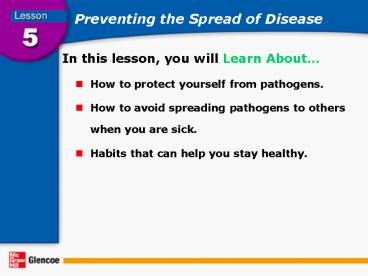Preventing the Spread of Disease - PowerPoint PPT Presentation
1 / 26
Title:
Preventing the Spread of Disease
Description:
Preventing the Spread of Disease In this lesson, you will Learn About How to protect yourself from pathogens. How to avoid spreading pathogens to others when you ... – PowerPoint PPT presentation
Number of Views:143
Avg rating:3.0/5.0
Title: Preventing the Spread of Disease
1
Preventing the Spread of Disease
- In this lesson, you will Learn About
- How to protect yourself from pathogens.
- How to avoid spreading pathogens to others when
you are sick. - Habits that can help you stay healthy.
2
Preventing the Spread of Disease
- The Vocabulary term in this lesson is
- Hygiene.
3
Stop Pathogens from Spreading
Although you cannot see the pathogens that
surround you, you can defend yourself against
them. Good personal hygiene and other healthful
habits can help you stay well. Keeping your
environment clean is also an important part of
preventing the spread of pathogens.
4
Protect Yourself
- Avoid taking risks with your health. Here are
some guidelines to protect yourself - Avoid close contact with people who are ill,
especially during the contagious period of a
disease. - Do not share eating utensils, dishes, glasses,
bottles, or cans. - Wash your hands often, especially when you have
been around someone with a contagious disease.
5
Handwashing
Frequent handwashing will help keep pathogens
from entering your body.
How to Wash First, wet your hands under warm
running water and apply soap. Then, rub your
hands together vigorously, and scrub all surfaces
for at least 15 seconds. Finally, rinse well and
dry your hands, using a clean or disposable
towel.
When to Wash Always wash your hands before
handling or eating food.
What to Use Wash with hot, soapy water. Consider
buying liquid soap.
6
Protect Others
- To avoid spreading of pathogens to others, do the
following - If you are ill, stay home from school during the
contagious period of the disease, and avoid close
contact with other people. Wash your hands
frequently. - Cover your mouth and nose when you cough or
sneeze, and turn your head away from others. Use
tissues and dispose of them properly.
7
Protect Others (contd.)
Get medical treatment if you need it. Delaying a
visit to the doctor may allow your condition to
worsen while increasing the chances that you will
spread pathogens to others. When you take a
prescribed medication, follow the directions and
your physicians orders carefully. Take the
entire cycle of prescribed medication. Do not
stop taking it just because you feel
better. Encourage other people to follow wise
health practices.
8
Develop a Healthy Lifestyle
- These healthful habits are important
- weapons in the fight against pathogens
- Eating a balanced diet.
- Participating in regular physical activity.
- Getting enough rest.
- Bathing or showering daily.
- Avoiding harmful behaviors such as using tobacco,
alcohol, or other drugs.
9
Develop a Healthy Lifestyle (contd.)
- You can do even more to help your body stay
healthy - When you are sick, avoid strenuous activity.
- Be sure that you are immunized against diseases
for which a vaccine exists. - Learn to manage stress.
- Get regular health screenings.
10
Reviewing Terms and Facts
- Define the term hygiene.
- Hygiene means cleanliness.
11
Reviewing Terms and Facts
- List three ways to protect yourself against
communicable diseases.
- Avoid close contact with people who are ill.
- Do not share eating utensils, dishes, glasses,
bottles, or cans. - Wash your hands often.
12
Thinking Critically
- Why do you think it is important to wash your
hands after playing with a pet?
13
Chapter Review
14
Reviewing Terms and Facts
- _____ are organisms that are so small that they
can be seen only through a microscope.
Germs
15
Reviewing Terms and Facts
- The ______________ is a secondary circulatory
system that helps the body fight pathogens and
maintain its fluid balance.
lymphatic system
16
Reviewing Terms and Facts
- Yellowing of the skin and the whites of the
eyes is a sign of
- influenza.
- mononucleosis.
- hepatitis.
- strep throat.
17
Reviewing Terms and Facts
- Yellowing of the skin and the whites of the
eyes is a sign of
- influenza.
- mononucleosis.
- hepatitis.
- strep throat.
18
Reviewing Terms and Facts
- Chlamydia is an STD that may affect the
reproductive organs, urethra, and anus.
- True
- False
19
Reviewing Terms and Facts
- Chlamydia is an STD that may affect the
reproductive organs, urethra, and anus.
- True
- False
20
Reviewing Terms and Facts
- It is important to avoid contact with others
during the contagious period of a disease.
- True
- False
21
Reviewing Terms and Facts
- It is important to avoid contact with others
during the contagious period of a disease.
- True
- False
22
Thinking Critically
- How can understanding the ways in which pathogens
are spread help people stay healthy?
23
Thinking Critically
- Explain how lymph, the lymph nodes, and
lymphocyte work within the lymphatic system to
fight against specific pathogens.
24
Thinking Critically
- The following diseases are caused by pathogens a
cold, the flu, mononucleosis, and TB. What are
the risks for contracting each disease?
25
Thinking Critically
- Why do you think people often postpone seeing a
doctor if they think that they might have an STD?
26
Thinking Critically
- A friend tells you that shes planning
- to go to school even though she has the flu.
What would you tell her?































